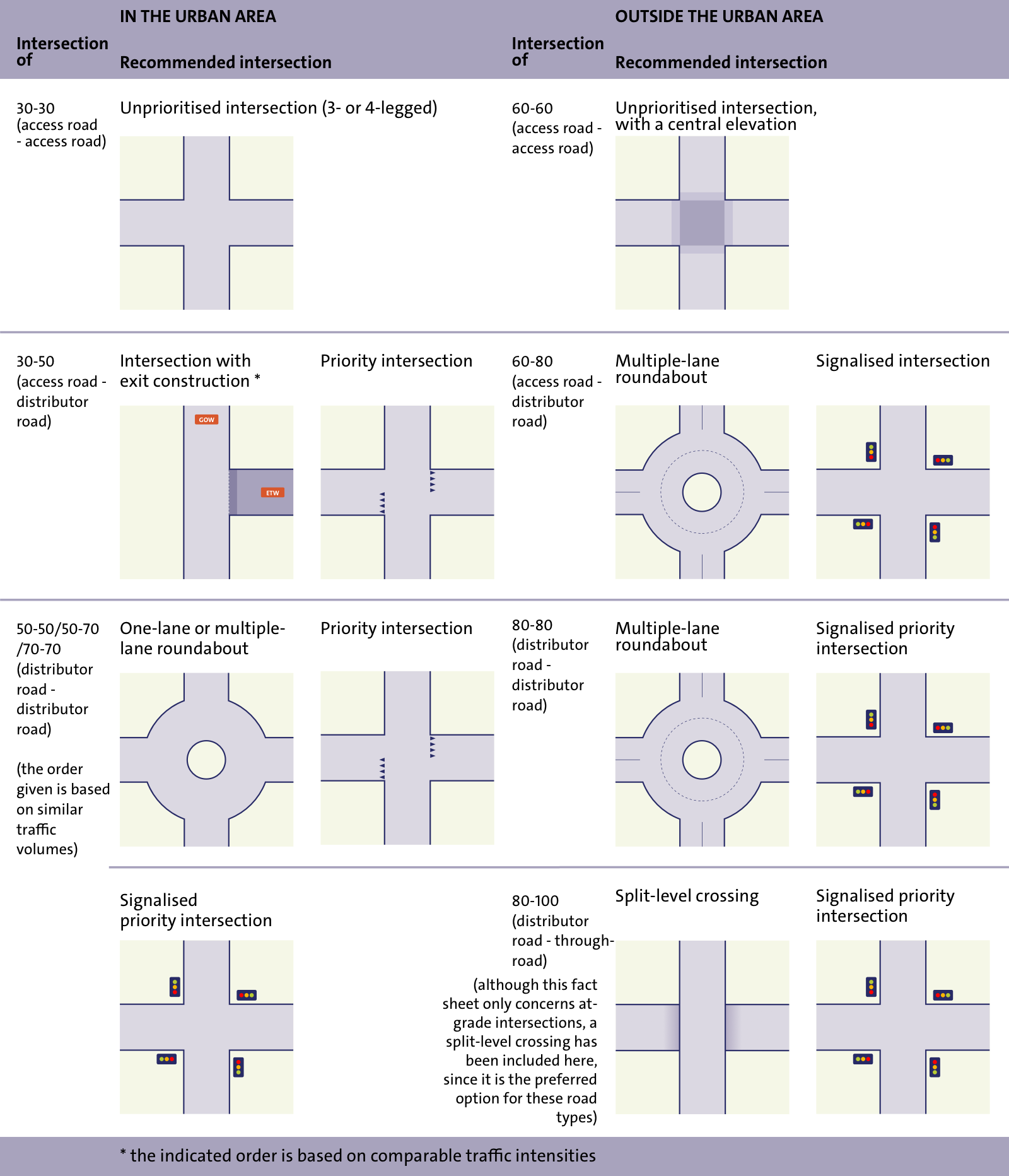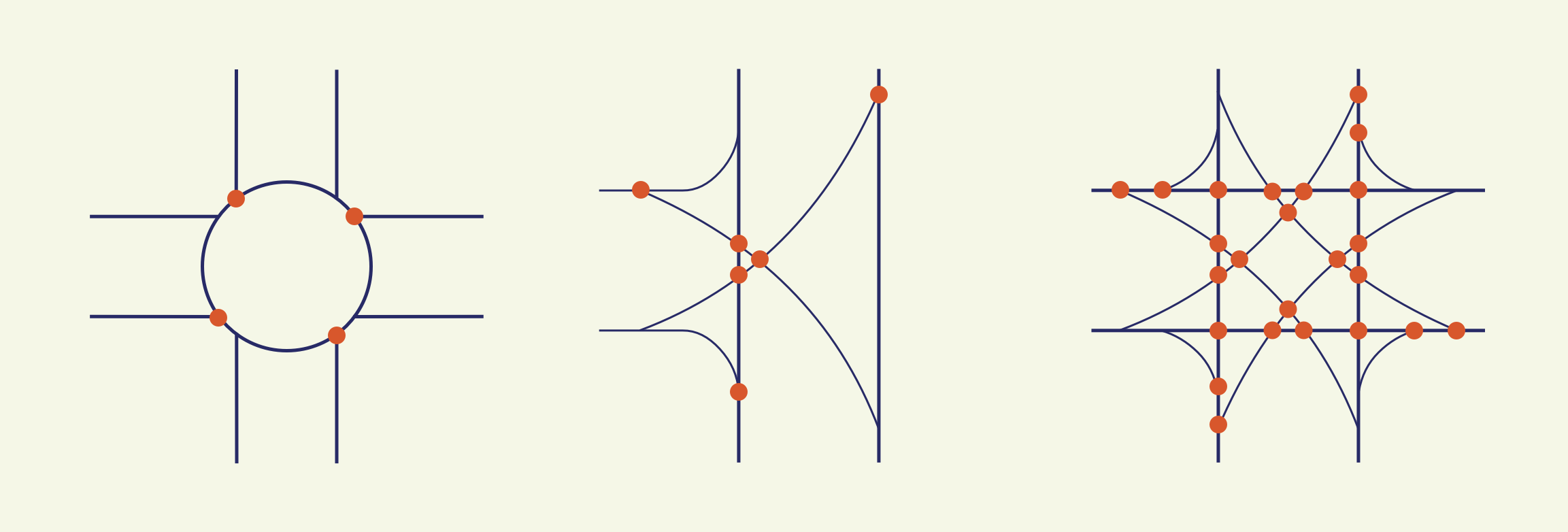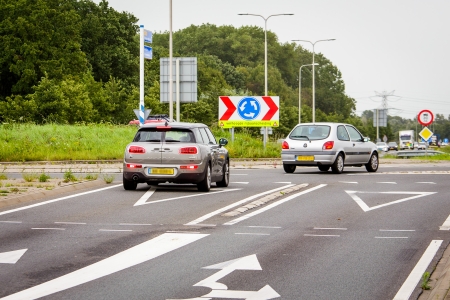Below you will find the list of references that are used in this fact sheet; all sources can be consulted or retrieved. Via Publications you can find more literature on the subject of road safety.
[1]. CROW (2015). Basiskenmerken kruispunten en rotondes. Publicatie 315A. CROW Kenniscentrum voor verkeer, vervoer en infrastructuur, Ede.
[2]. Wegenwiki (2009). Gelijkvloers. Wegenwiki. Accessed on 21-12-2020 at www.wegenwiki.nl/Gelijkvloers.
[3]. Wegenwiki (2015). Kruispunt. Wegenwiki. Accessed on 21-12-2020 at www.wegenwiki.nl/Kruispunt.
[4]. Wikipedia (2013). Bajonetkruispunt. Wikipedia. Accessed on 21-12-2020 at nl.wikipedia.org/wiki/Bajonetkruispunt.
[5]. Wegenwiki (2018). Voorrangsplein. Wegenwiki. Accessed on 21-12-2020 at www.wegenwiki.nl/Voorrangsplein.
[6]. Aarts, L.T. & Dijkstra, A. (2018). DV3 - Achtergronden en uitwerking van de verkeersveiligheidsvisie. De visie Duurzaam Veilig Wegverkeer voor de periode 2018 – 2030 onderbouwd [Sustainable Safety version 3 – Backgrounds and elaboration of the updated road safety vision. Substantiation of the second advanced Sustainable Safety vision for the period 2018-2030]. R-2018-6B [Summary in English]. SWOV, Den Haag.
[7]. CROW-Fietsberaad (2019). Evaluatie discussienotitie Fietsstraten. Fietsberaadpublicatie 32. CROW-Fietsberaad, Utrecht.
[8]. CROW (2019). Handboek wegontwerp 2013: basiscriteria. CROW, Ede.
[9]. Dijkstra, A. (2014). Enkele aspecten van kruispuntveiligheid. Rapportage voor het CROW-project Afwegingskader kruispunten [Several aspects of intersection safety. Report for the CROW project Assessment Framework for Intersections]. R-2014-21A [Summary in English]. SWOV, Den Haag.
[10]. Donkers, E. (2022). Is de fietser nog wel veilig op het kruispunt? Verbeter de fietsveiligheid door het verminderen van conflicten op kruispunten. Paper presented at NVVC, 12 april 2022, Utrecht.
[11]. Churchill, T., Stipdonk, H. & Bijleveld, F. (2010). Effects of roundabouts on road casualties in the Netherlands. R-2010-21. SWOV, Leidschendam.
[12]. Dijkstra, A. (2005). Rotondes met vrijliggende fietspaden ook veilig voor fietsers? Welke voorrangsregeling voor fietsers is veilig op rotondes in de bebouwde kom? [Are roundabouts with separate cycle tracks also safe for cyclists? Which priority rule is safe for cyclists on individual urban roundabouts?]. R-2004-14 [Summary in English]. SWOV, Leidschendam.
[13]. Bout, J. & Olijve, M.J. (2015). Het voorrangsplein: een nieuw kruispunttype?! Onderzoek naar de verkeersveiligheid en de capaciteit op voorrangspleinen. Hogeschool Windesheim, Zwolle.
[14]. Leeden, E.P.J. van der (2012). A comparison between the pleintje, priority intersection & roundabout. Master thesis. Technische Universiteit Delft, Goudappel Coffeng, Delft.
[15]. Reimink, J. & Wiersum, M. (2018). Voorrangspleinen buiten de bebouwde kom. HBO afstudeeronderzoek. Hogeschool Windesheim, Zwolle.
[16]. Janssen, S.T.M.C. (1992). Veiligheid van ongelijkvloerse kruispunten op enkelbaanswegen. Een verslag van een onderzoek voor de Werkgroep 'Ongelijkvloerse kruispunten enkelbaanswegen' van de Stichting Centrum voor Regelgeving en Onderzoek in de Grond-, Water-, en Wegenbouw en de Verkeerstechniek, C.R.O.W. R-92-35. SWOV, Leidschendam.
[17]. Elvik, R., Høye, A., Vaa, T. & Sørensen, M. (2009). Traffic control. In: The handbook of road safety measures [2nd edition]. Emerald Group Publishing Limited, p. 397-541.
[18]. Ziakopoulos, A., Botteghi, G. & Papadimitriou, E. (2017). Traffic signal installation. European Road Safety Decision Support System, developed by the H2020 project SafetyCube. Accessed on 10-03-2021 at www.roadsafety-dss.eu.
[19]. Janssen, S.T.M.C. (2004). Veiligheid op kruisingen van verkeersaders binnen de bebouwde kom. Vergelijking van ongevallenrisico's [Safety on urban through-road intersections. Comparison of crash rates]. R-2003-36 [Summary in English]. SWOV, Leidschendam.
[20]. Elvik, R., Høye, A., Vaa, T. & Sørensen, M. (2009). Road design and road equipment. In: The handbook of road safety measures [2nd edition]. Emerald Group Publishing Limited, p. 144-333.
[21]. Minnen, J. van (1990). Ongevallen op rotondes. Vergelijkende studie van de onveiligheid op een aantal locaties waar een kruispunt werd vervangen door een 'nieuwe' rotonde. R-90-47. SWOV, Leidschendam.
[22]. Wijnen, W., Weijermars, W.A.M. & Bos, N.M. (2013). Update effectiviteit en kosten van verkeersveiligheidsmaatregelen. Nieuwe schattingen voor elf maatregelen [Update effectiveness and costs of road safety measures. New estimates for eleven measures]. D-2013-7 [Summary in English]. SWOV, Den Haag.
[23]. Fortuijn, L.G.H. (2009). Turbo roundabouts: Design principles and safety performance. In: Compendium of papers DVD 88th Annual Meeting of the Transportation Research Board TRB. Washington D.C.
[24]. Fortuijn, L.G.H. (2013). Turborotonde en turboplein: ontwerp, capaciteit en veiligheid. Doctoral thesis. Technical University Delft. Delft.
[25]. Schoon, C.C., Doumen, M.J.A. & Bruin, D. de (2008). De toedracht van dodehoekongevallen en maatregelen voor de korte en lange termijn. Een ongevallenanalyse over de jaren 1997-2007, verkeersobservaties en enquêtes onder fietsers en vrachtautochauffeurs [The circumstances of blind spot crashes and short- and long-term measures. A crash analysis over the years 1997-2007, traffic observations, and surveys among cyclists and lorry drivers]. R-2008-11A [Summary in English]. SWOV, Leidschendam.
[26]. Schepers, J.P. & Voorham, J. (2010). Oversteekongevallen met fietsers. Het effect van infrastructuurkenmerken op voorrangskruispunten. Directoraat-Generaal Rijkswaterstaat, Dienst Verkeer en Scheepvaars DVS, Delft.
[27]. Boggelen, O. van, Schepers, P., Kroeze, P. & Voet, M. van der (2011). Samen werken aan een veilige fietsomgeving. Fietsberaadpublicatie 19. Fietsberaad, Utrecht.
[28]. Daniels, S., Brijs, T., Nuyts, E. & Wets, G. (2009). Injury crashes with bicyclists at roundabouts: influence of some location characteristics and the design of cycle facilities. In: Journal of Safety Research, vol. 40, p. 141-148.
[29]. Jensen, S. (2013). Safety effects of converting intersections to roundabouts. In: Transportation Research Record, nr. 2389, p. 22-29.
[30]. Minnen, J. van (1995). Rotondes en voorrangsregelingen [Roundabouts and the priority rule]. R-95-58 [Summary in English]. SWOV, Leidschendam.
[31]. Minnen, J. van (1998). Rotondes en voorrangsregelingen II. Uniformering voorrangsregeling op oudere pleinen, veiligheid fietsvoorzieningen en tweestrooks rotondes [Roundabouts and right-of-way regulations II. Standardising right-of-way regulations on older roundabouts, the safety of cycling facilities, and two-lane roundabouts]. R-98-12 [Summary in English]. SWOV, Leidschendam.
[32]. DTV Consultants (2019). Verkenning verkeersveiligheid op rotondes in Nederland. Memo. DTV Consultants, Breda.
[33]. Soteropoulos, A. & Stadlbauer, S. (2017). Convert junction to roundabout. European Road Safety Decision Support System, developed by the H2020 project SafetyCube. Accessed on 21-12-2020 at www.roadsafety-dss.eu.
[34]. AD (2022). ‘Heilige graal van verkeersveiligheid’ blijkt gevaarlijker voor fietsers dan gedacht. Algemeen Dagblad. Geraadpleegd 03-06-2022 op https://www.ad.nl/auto/heilige-graal-van-verkeersveiligheid-blijkt-gevaarlijker-voor-fietsers-dan-gedacht~a116748a/.
[35]. Bentem, L. van (2022). The impact of infrastructure design on cycling safety. Master thesis TU Delft Civil Engineering and Geosciences. Delft University of Technology.
[36]. CROW (2016). Ontwerpwijzer fietsverkeer. Publicatie 351. CROW Kenniscentrum voor verkeer, vervoer en infrastructuur, Ede.
[37]. Granà, A. (2011). An overview of safety effects on pedestrians at modern roundabouts. In: Brebbia, C.A. & Beriatos, E. (red.), Sustainable Development and Planning V. WIT Transactions on Ecology and the Environment, Southampton, p. 261-272.
[38]. Brude, U. (2000). What roundabout design provided the highest possible safety? Swedish National Road and Transport Research Institute (VTI).
[39]. Soteropoulos, A. & Stadlbauer, S. (2016). Risk of different junction types. European Road Safety Decision Support System, developed by the H2020 project SafetyCube. Accessed on 10-03-2021 at www.roadsafety-dss.eu.
[40]. iRAP (2013). Road attribute risk factors. Intersection type. International Road Assessment Programme (iRAP).
[41]. Chen, L., Chen, C. & Ewing, R. (2012). The relative effectiveness of pedestrian safety countermeasures at urban intersections — Lessons from a New York City experience. Contribution to the Transportation Research Board 91st Annual Meeting, Washington, D.C.
[42]. Federal Highway Administration (2009). Pedestrian safety at intersections. FHWA-SA-10-005. Department of Transportation DOT, Federal Highway Administration FHWA, Washington, D.C.
[43]. Nitzburg, M. & Knoblauch, R.L. (2001). An evaluation of high-visibility crosswalk treatments - Clearwater, Florida. FHWA-RD-00-105. Federal Highway Administration, McLean.
[44]. Fitzpatrick, K., Turner, S., Brewer, M., Carlson, P., et al. (2006). Improving pedestrian safety at unsignalized crossings. Transportation Research Board, Washington, D.C.
[45]. Zegeer, C.V., Stewart, J.R., Huang, H.H., Lagerwey, P.A., et al. (2005). Safety effects of marked versus unmarked crosswalks at uncontrolled locations: Final report and recommended guidelines. FHWA–HRT–04–100. Federal Highway Administration’s (FHWA), Washington.


 Figure 1. The differences in conflict points between roundabouts, three-legged and four-legged intersections.
Figure 1. The differences in conflict points between roundabouts, three-legged and four-legged intersections.